Keeping your gun clean isn't optional - it's essential. Whether you shoot once a month or every weekend, regular cleaning protects your gear, improves accuracy, and ensures safe, reliable performance. This guide walks you through everything you need to know, from the tools you'll need to step-by-step instructions for cleaning handguns, rifles, and airguns. Whether you're a first-time owner or a seasoned shooter, this is your go-to resource for proper gun care.
The Beginner's Gun Cleaning Guide is perfect for:
- First-time gun owners learning how to clean safely and correctly
- Airgun shooters who want to protect seals and improve longevity
- Firearm owners looking to avoid malfunctions and keep their guns reliable
- Anyone unsure which cleaning kit or tools they actually need
- Shooters preparing for long-term storage or post-range maintenance
- Hunters who want consistent performance in the field
- Why Gun Cleaning Matters
- What You Need Before You Start
- Gun Cleaning Kits
- Common Tools for Gun Cleaning
- The Gun Cleaning Process
- Cleaning by Gun Type
- Best Gun Kits & Tools
- Gun Cleaning Tips from the Experts
- Common Gun Cleaning Questions
- Do I need to clean a new gun before first use?
- How much lubricant should I use?
- Can I use household cleaners or oils for gun cleaning?
- Additional Resources
Why Gun Cleaning Matters
Regular gun cleaning isn't just about keeping your gear looking good; it's essential for safety, reliability, and consistent performance.
Every time you fire a gun, residue builds up inside the barrel and action. This includes carbon fouling from burnt powder, lead or copper deposits from bullets or pellets, and even moisture or dust from storage or outdoor use. Over time, this fouling sticks to the bore and working parts of your gun. If it's not cleaned properly, it can lead to decreased accuracy, feeding issues, or unnecessary wear on components.
Clean guns are safer to operate. A dirty gun is more likely to jam, misfire, or fail to cycle correctly. Buildup can cause light primer strikes, prevent the action from locking up properly, or lead to rust and corrosion, especially if the gun is stored in poor conditions. Regular cleaning helps reduce the risk of these problems and keeps your gear functioning reliably.
Cleaning also ensures consistent performance. A smooth, fouling-free barrel helps maintain accuracy shot after shot. Proper lubrication keeps moving parts running smoothly. For airgun owners, keeping seals clean and oiled helps maintain optimal pressure and velocity. Whether you're shooting paper targets, controlling pests, or hunting small game, a clean gun delivers better results every time.
Taking a few minutes to clean your gun not only protects your investment but also extends its life and ensures it's always ready when you need it.
What You Need Before You Start
Gun Cleaning Kits
A gun cleaning kit includes the essential tools and chemicals needed to clean, maintain, and lubricate firearms or airguns. These tools help remove carbon, lead, copper, and other residue that builds up in the barrel and action during shooting.
Gun cleaning kits fall into two main types: universal kits and specific kits.
Universal kits come with tools and accessories to clean multiple types of firearms: handguns, rifles, and shotguns. They usually include:
- Multiple caliber brushes and jags
- Assorted rods or pull-through cables
- Solvent and oil
- Patches, mops, picks, and swabs
- A hard or soft case for storage
If you have more than one type of gun or if you are looking to clean a variety of calibers, you should consider using a universal kit. Universal kits are helpful for:
- As a new gun owner wanting a one-kit-cleans-all solution
- As a family that mixes multiple types of firearms
- As range bags that allow for multiple firearms while on-the-go
You should also remember that universal kits can be cumbersome, and the tools included may not fit every barrel as intended, since you will need brush and jag sizes that accommodate your gun calibers.
Specific kits are designed for a specific type or caliber of firearm, i.e., a 9mm pistol, a .22 rifle, or a 12-gauge shotgun. Specific kits usually have:
- Caliber-specific rods or cables
- One or two brush sizes
- Matching jag, mops, and patches
- Small bottles of cleaner and lubricant
Use a specific kit if you mostly shoot one type of firearm. They're ideal for:
- Airgun owners who need seal-safe cleaners
- Handgun owners looking for compact gear
- Hunters carrying only a rifle or shotgun in the field
- Kits that fit in small bags or cases
But, they aren't flexible. If you buy a new gun in another caliber, you'll likely need a second kit or add-on tools.
Common Tools for Gun Cleaning
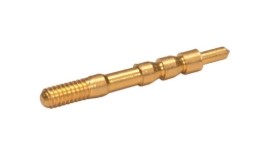
Jag
A pointed tip that attaches to the rod and holds a cleaning patch snugly. It helps apply solvent and scrub the full inner surface of the barrel.
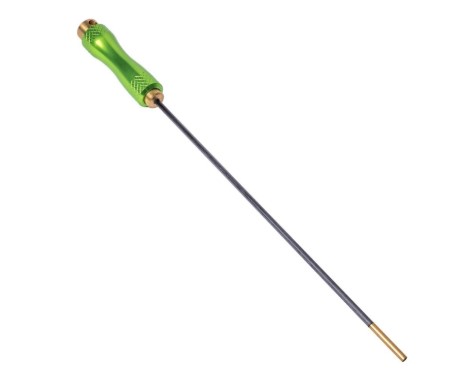
Rod
A long, straight metal or carbon fiber tool used to push cleaning accessories like brushes, jags, or patches through the gun barrel. It helps scrub and remove fouling from inside the bore.
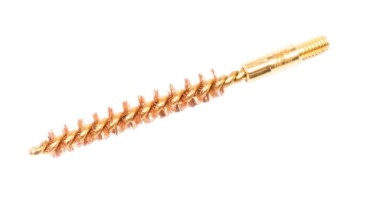
Brush
A brush has stiff bristles, usually made of bronze or nylon, that scrub away carbon, lead, and powder residue inside the barrel. Brushes come in different sizes for different calibers.
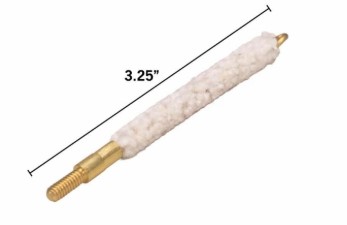
Mop
A mop is a soft, cotton swab that also attaches to the cleaning rod. It's used to apply oil or give the barrel a final polish after cleaning.
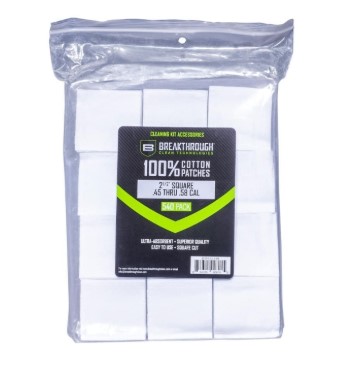
Patch
A patch is a small piece of cloth soaked in solvent or oil. It's used with a jag or a slotted tip to clean, wipe, or lubricate the barrel. Patches help carry out dirt and residue.
Gun Cleaning Supplies
Choosing the right cleaning supplies makes a big difference in how well your gun performs and how easy it is to maintain. The most important items? Solvents, CLP, and lubricants. Let's break them down.
Solvents vs. CLP
Gun cleaning solvents are designed to break down and dissolve carbon, lead, copper, and powder fouling. These are best when your gun is really dirty or hasn't been cleaned in a while. Solvents are great for deep cleaning barrels and internal parts, but they usually need to be followed up with oil or lubricant to protect the metal.
CLP stands for Clean, Lubricate, Protect. It's a 3-in-1 solution that does a decent job of removing light fouling, lubricating moving parts, and leaving behind a protective layer. CLP is ideal for routine cleanings or field use when time and space are limited. If you shoot often or clean after every session, CLP can be a quick and effective solution.
Use solvents for deep cleans. Use CLP for quicker touch-ups or maintenance between heavy uses.
Non-Toxic and Synthetic Options
Many modern gun cleaners are non-toxic, biodegradable, and synthetic. These are great if you're concerned about health, harsh smells, or environmental impact. They're safer to use indoors or around kids and pets, and they work well without the strong chemical fumes of older formulas.
Synthetic oils and greases are also more stable across temperature changes. They won't gum up or break down as easily in extreme heat or cold, which makes them great for hunting, range use, and long-term storage.
If you're cleaning airguns, be sure to use airgun-safe oils that won't damage seals. Avoid petroleum-based products unless they're specifically rated for use in airguns.
Choosing the right cleaning supplies helps protect your gun and makes every cleaning session faster and more effective. Keep both solvents and CLP in your gear bag, and you'll be ready for anything.
Safety Essentials
Cleaning a gun is safe when done right, but it's still important to protect yourself and your workspace. Here are the basics:
- Eye Protection: Always wear safety glasses. Cleaning solvents can splash, and tiny debris or springs can pop loose when disassembling your gun.
- Ventilation and Lighting: Use a well-ventilated space to avoid breathing in fumes from solvents or oils. A well-lit area also helps you see small parts clearly and avoid mistakes.
- Gloves: Nitrile or latex gloves keep your hands clean and protect your skin from harsh chemicals. They also help you keep a solid grip on parts during cleaning.
- Cleaning Mats: Use a soft, padded mat or dedicated gun cleaning mat. It keeps small parts from rolling away and protects your work surface from solvents, oil, and scratches.
These simple steps keep you safe, your workspace clean, and your gun maintenance routine more efficient.
The Gun Cleaning Process: Step-by-Step Instructions
Cleaning your gun doesn't have to be complicated. To maintain your firearm or airgun in proper working condition, you can simply follow these five basic steps. It doesn't matter if it's a handgun, rifle, or an airgun; they are all relatively similar and require a few adjustments to accommodate the size, design, and materials of your gun.
Step 1 -- Unload and Disassemble
The first step is always to ensure the gun is unloaded. Remove the magazine, check the chamber, and conduct a visual inspection to confirm that no ammunition is present. Safety first!
Now, you should organize your workspace. Choose a flat, clean, illuminated, ventilated work area. Lay down the gun cleaning mat so as to not scratch your parts while also giving you an organizational structure. Disassemble the firearm according to the manufacturer's instructions, only as far as to gain access to the bore, action, and moving parts.
Step 2 -- Clean the Bore
Start with the bore, the inside of the barrel where most fouling builds up. If it's lightly fouled from just a few shots, a couple of solvent-soaked patches followed by a dry one may be enough. For heavy fouling, especially after a long session or when cleaning for the first time, use a bronze brush to scrub the bore thoroughly.
Push the brush through the bore several times, then follow with solvent-soaked patches. Repeat until the patches come out clean. For tighter or curved areas, a pull-through cleaning tool, such as the Patchworm, is a great option, especially for airguns, where rod use can damage seals.
Step 3 -- Clean the Action and Other Parts
Once the bore is clean, move on to the action, slide, bolt, trigger group, and other exposed components. These areas can collect powder residue, carbon buildup, and grit from handling.
Use Q-tips, cotton swabs, nylon brushes, and dental picks to access small corners and hard-to-reach areas. Apply a small amount of solvent to loosen grime, then wipe everything down with clean patches or cloths. For airguns, avoid harsh chemicals and stick with seal-safe cleaners that won't damage O-rings or internal valves.
Step 4 -- Lubricate Moving Parts
After everything is dry, apply a light coat of lubricant to moving parts like:
- Slide rails
- Bolt carriers
- Trigger contact points
- Barrel lugs and pins
Use a high-quality gun oil or synthetic lubricant, and avoid over-lubricating the gun; a light film is all that's necessary. Wipe off the excess, because excess oil can retain dirt or become gummy over time. Airgun users should only use lubricants that state they are airgun-safe, as lubricants meant for firearms can wreak havoc on seals and pressure systems.
Step 5 - Reassemble and Check Function
After cleaning and lubricating every part, check the owner's manual for details on reassembling the gun. Make sure every piece is in line, every pin is in place, and every part is able to move without restriction.
Do a basic function check: cycle the slide, dry fire (if applicable for your type of gun), and make sure everything feels proper. Wipe a clean cloth over the exterior of the gun, then place a light coat of oil to protect the metal surfaces from moisture or rust.
Cleaning your gun regularly will keep it functioning smoothly, help diagnose accuracy problems, and prolong the firearm's life. This whole process will take less than 30 minutes with a little practice, and it is one of the best habits responsible shooters can cultivate.
Cleaning by Gun Type
Not all guns clean the same way. The tools and techniques you use will vary depending on whether you're maintaining a handgun, rifle, or air gun. Choosing the right gear for your gun type helps you clean more effectively and avoid damage.
Handguns
Handguns have short barrels, so they don't require long rods. Most handgun cleaning kits include:
- Short cleaning rods or pull-through cables
- Caliber-specific brushes and jags
- Compact carrying cases for range use
A solid cleaning technique includes pushing patches from breech to muzzle when possible, using solvent-soaked patches to break up fouling, followed by dry ones to remove residue, and finally a light coat of oil for protection.
Rifles
Rifles have longer barrels, so you'll need:
- Longer rods to reach all the way through
- Bore guides center the rod and protect the chamber and rifling
- Tight-fitting jags and patches for better contact with the bore
Always clean from the breech end, if possible, to avoid damaging the crown of the barrel. For precision rifles, take extra care not to over-lubricate - too much oil can attract dust or affect accuracy.
Air guns
Air guns need a different approach. They often have delicate internal seals and don't produce the same kind of fouling as powder-burning guns. That means:
- Use Seal-safe lubricants only - never use petroleum-based products unless they're air gun-rated
- Specialized air gun cleaning rods or pull-through kits like the Patchworm system
- Cleaning pellets that can be fired through the barrel (for springers only)
Avoid over-cleaning air gun barrels. Many air gun shooters clean only when accuracy drops or after extended use. PCP, CO2, and spring-piston guns may all require different care, so check your owner's manual before starting. Explore our air gun maintenance guides for tips, tools, and expert advice.
Each kit is designed to match the caliber, barrel length, and material requirements of your gun. Using the right one helps protect your gun and makes cleaning faster and easier.
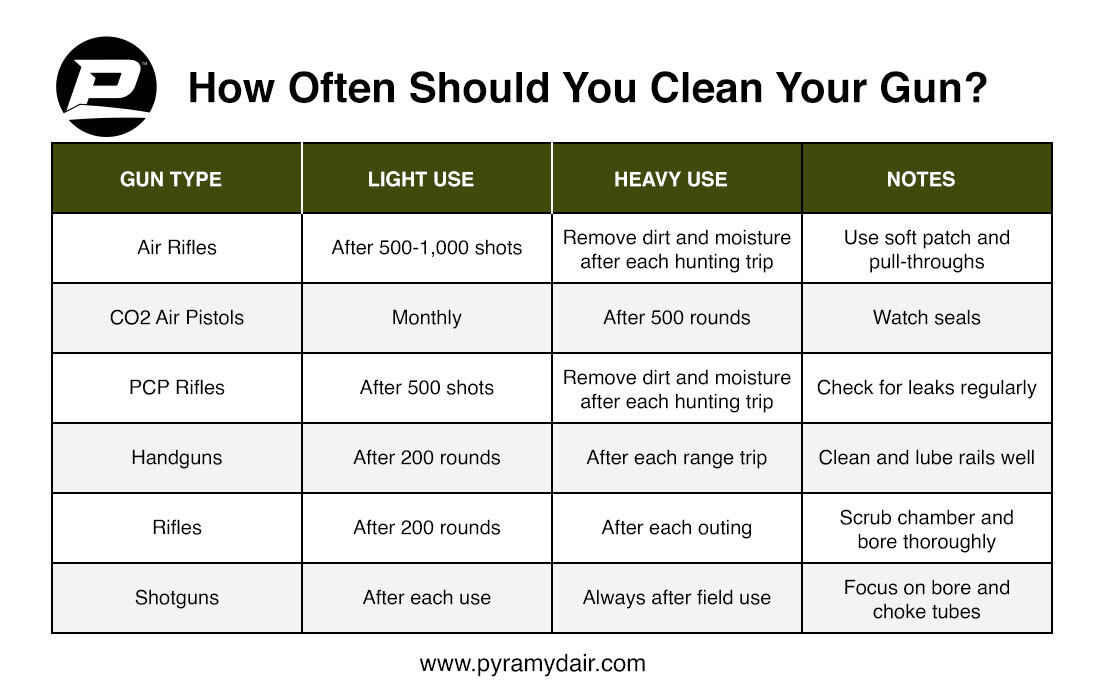
Top Picks: Best Gun Kits & Tools
Not all cleaning kits are created equal. The right kit makes cleaning easier, more effective, and safer for your gear.
- Best Universal Kit - Allen Universal Gun Cleaning Kit & Tool Box
- Best Handgun Kit - Allen Ruger Universal Handgun Cleaning Kit
- Best Air Gun Kit - Umarex Airgun Cleaning Kit
Ready to keep your guns in top shape? Shop all our cleaning kits and find the perfect setup for your handgun, rifle, or air gun.
Gun Cleaning Tips from the Experts
How to avoid common mistakes
One of the most common mistakes people make is cleaning from the muzzle instead of the breech. Always clean from the breech end when possible to protect the barrel crown and rifling, which are essential for accuracy. Another easy mistake is using the wrong-sized tools. Make sure your brushes, jags, and patches match your gun's caliber. Oversized tools can get stuck; undersized ones won't clean effectively. It's also important not to over-lubricate your gun. While oil protects metal, too much can collect dust or affect performance. And if you're using an airgun, stick to seal-safe oils and avoid harsh chemicals meant for firearms. Lastly, don't rush. Take your time and follow a step-by-step process to clean each part thoroughly.
Recommended practices for long-term storage
If you're storing your gun for the season or in long-term storage, a few extra steps will help keep it in top shape. Always start by thoroughly cleaning the gun; remove all fouling, moisture, and debris. Apply a thin layer of gun oil to protect the metal surfaces from rust. Store the gun in a soft gun sock or padded case, but avoid foam-lined hard cases for long-term use as they can trap moisture. Keep your storage area dry, and consider using a dehumidifier or silica gel packs in your safe or cabinet. It's also smart to check your guns every few months, give them a quick wipe-down, and reapply oil if needed.
When to see a gunsmith
Sometimes, a professional touch is the best option. If you see deep rust, pitting, or serious buildup, it's time to visit a gunsmith. If the action feels stiff, gritty, or inconsistent after a full cleaning, there could be a mechanical issue that needs expert care. You should also seek help if you're unsure how to disassemble a specific model or if you want to install or repair internal parts like triggers, barrels, or springs. A certified gunsmith has the tools and knowledge to protect your gun and keep it performing safely.
Taking a few extra steps with cleaning and maintenance goes a long way in keeping your gun reliable, accurate, and safe, whether you're using it regularly or storing it for the season.
FAQs: Common Gun Cleaning Questions Answered
Do I need to clean a new gun before first use?
Yes, it's a smart move. Even new guns can have factory grease, packing oil, or leftover metal shavings from production. Cleaning it before the first use removes any unwanted residue and gives you a chance to inspect the gun for any issues. It also ensures the bore is clean and the moving parts are properly lubricated with the right products.
How much lubricant should I use?
Less is more. You only need a thin, even layer of lubricant on contact points, just enough to reduce friction and prevent wear. Too much oil can attract dust and carbon, leading to gumming or buildup over time. Focus on light coverage on the slide rails, bolt, trigger mechanism, or any other moving parts. Wipe off any excess with a clean cloth. For airguns, always use lubricants rated safe for seals, and avoid over-oiling to prevent pressure issues.
Can I use household cleaners or oils for gun cleaning?
It's not recommended. Household cleaners like WD-40, ammonia-based sprays, or motor oil aren't made for firearms and can cause more harm than good. Some can damage finishes, strip protective coatings, or break down important seals, especially in airguns. They also don't offer the same level of fouling removal, lubrication, or rust protection as gun-specific products. For best results and long-term reliability, stick with cleaners, oils, and greases made specifically for guns. They're formulated to protect the materials and tolerances found in firearms and airguns.






